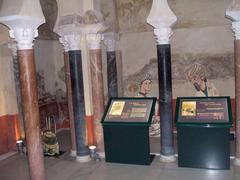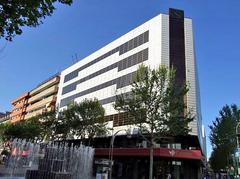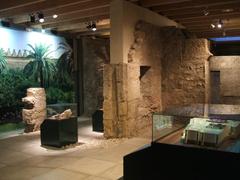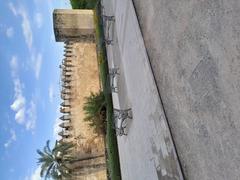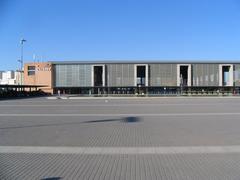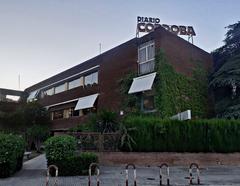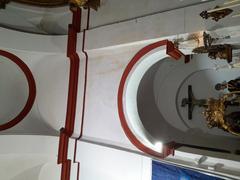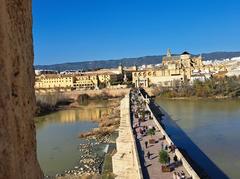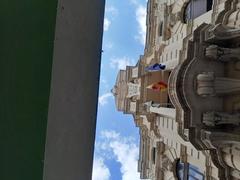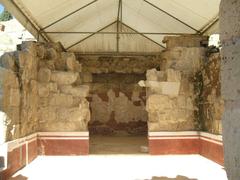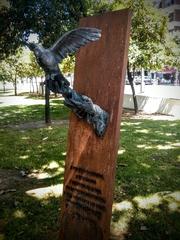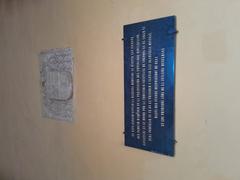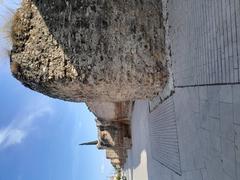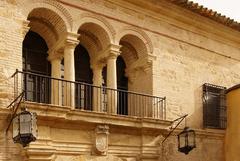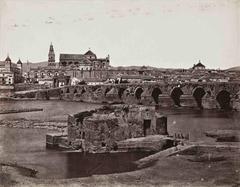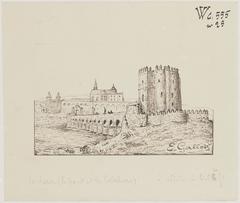Córdoba Synagogue: Visiting Hours, Tickets, and Historical Significance in Córdoba, Spain
Date: 15/06/2025
Introduction
Nestled in the heart of Córdoba’s historic Jewish Quarter (La Judería), the Córdoba Synagogue stands as a rare and evocative monument to Spain’s rich multicultural past and enduring Jewish heritage. Built in 1315 CE during a period of relative religious tolerance under Castilian rule, this medieval synagogue is one of only three surviving pre-expulsion synagogues in Spain and the only one in Andalusia. Its Mudéjar architecture—an intricate blend of Jewish, Islamic, and Christian artistic traditions—offers a unique lens through which to explore the city’s layered history of convivencia (coexistence) (Jewish Heritage Route, Spain.info, Jewish Virtual Library).
This guide provides essential information for visitors, including up-to-date opening hours, ticketing options, accessibility considerations, and insider tips. Whether you are a history enthusiast, architecture lover, or cultural traveler, the Córdoba Synagogue invites you to experience a profound narrative of resilience, artistry, and intercultural dialogue at the crossroads of Andalusian history.
Table of Contents
- Historical Background
- Architectural and Artistic Features
- Historical Transformations and Preservation
- Cultural Significance and Notable Figures
- Visiting the Córdoba Synagogue
- Nearby Attractions in the Jewish Quarter
- Visuals and Media
- Frequently Asked Questions (FAQ)
- Conclusion and Call to Action
- References and Official Sources
Historical Background
Origins and Construction
The Córdoba Synagogue, located at Calle de los Judíos 20, was constructed in 1315 (5075 in the Hebrew calendar) during a period of prosperity for the city’s Jewish community. Built under the Kingdom of Castile, it reflects the multicultural environment that flourished in Córdoba after the Christian reconquest in 1236. The synagogue’s founder, Isaac Moheb, is named in a Hebrew inscription found during restoration work. Its Mudéjar architectural style is a testament to the artistic synthesis of Jewish, Islamic, and Christian influences during this era (Jewish Heritage Route, Spain.info).
The Medieval Jewish Community
In the 10th and 11th centuries, Córdoba’s Jewish community was renowned for its intellectual and cultural achievements. Figures such as Hasdai ibn Shaprut and Moses Maimonides, the great philosopher and physician, emerged from this vibrant society (Jewish Virtual Library). The synagogue, situated in one of Europe’s best-preserved medieval Jewish neighborhoods, offers a tangible connection to this golden age of scholarship and coexistence.
Architectural and Artistic Features
Despite its modest size—measuring roughly 7 by 6.5 meters—the Córdoba Synagogue is celebrated for its exquisite Mudéjar decoration. The main prayer hall is adorned with intricate stucco panels, geometric and vegetal motifs, and elegant Hebrew inscriptions, some featuring verses from the Psalms. Horseshoe arches, inspired by Islamic architecture, support the upper women’s gallery and echo the nearby Mezquita’s design (Wellesley College, isharethese.com).
Key features include:
- Main Prayer Hall: Rectangular, with a high, angled ceiling and a heikhal (ark) on the eastern wall framed by Mudéjar stucco.
- Women’s Gallery: Overlooks the hall via three horseshoe arches, accessed by a staircase.
- Courtyard and Vestibule: Provides a tranquil transition from the bustling Jewish Quarter to the intimate interior.
- Decorative Elements: Geometric and floral stucco, stylized beams, and biblical Hebrew inscriptions.
The synagogue’s understated exterior reflects 14th-century laws restricting non-Christian religious buildings, but the interior is a masterpiece of Mudéjar artistry (cordobatickets.com, andalucialovers.com).
Historical Transformations and Preservation
Following the expulsion of Jews from Spain in 1492, the synagogue was converted for other uses, including a hospital, a Catholic chapel, and a shoemakers’ guild hall. Rediscovered in the late 19th century, it was declared a National Monument in 1885 and underwent careful restoration to recover its original features (Spain.info, Templeseeker).
Cultural Significance and Notable Figures
The synagogue is a powerful symbol of Córdoba’s Jewish heritage and the city’s tradition of religious coexistence. Prominent figures connected to Córdoba’s Jewish life include:
- Moses Maimonides (1135–1204): Although he lived before the synagogue’s construction, Maimonides’ philosophical and medical legacy is celebrated in the city. His statue stands near the synagogue in Plaza de Tiberiades (Jewish Virtual Library, Explorial).
- Hasdai ibn Shaprut: A leading scholar and diplomat, he fostered an era of Jewish prosperity in Córdoba.
The synagogue, together with the Mezquita and Alcázar de los Reyes Cristianos, forms part of Córdoba’s UNESCO World Heritage–listed cultural landscape (Spain.info).
Visiting the Córdoba Synagogue
Opening Hours
- Tuesday to Saturday: 10:00 AM – 6:30 PM
- Sunday: 10:00 AM – 2:30 PM
- Monday: Closed
- Public Holidays: Hours may vary—always confirm in advance (Spain.info, Vitium Córdoba).
Tickets and Admission
- EU Residents: Free entry
- Non-EU Visitors: Nominal fee (typically €1.50 or less)
- Children/Students: Discounts or free admission, depending on age and status
- Where to buy: Onsite at the entrance or via official tourism websites. Guided tour tickets can be booked through local agencies (Vitium Córdoba).
Accessibility
- The main entrance and prayer hall are wheelchair accessible via ramps.
- Some areas, such as the women’s gallery, are not accessible due to original medieval architecture and stairs.
- The synagogue is located in a pedestrian zone with cobblestone streets; comfortable footwear is recommended.
Visitor Tips
- Best Times: Early mornings and weekdays are less crowded.
- Guided Tours: Highly recommended for deeper historical context; available in multiple languages.
- Photography: Allowed, but avoid flash and tripods to protect delicate interiors.
- Conduct: Respectful behavior and modest dress are expected; no eating or loud conversations inside.
- Facilities: No restrooms inside; facilities are available nearby.
Nearby Attractions in the Jewish Quarter
- Casa de Sefarad: Museum of Sephardic Jewish culture, just steps from the synagogue.
- Plaza de Tiberiades: Home to the statue of Maimonides.
- Mezquita-Catedral: Córdoba’s iconic mosque-cathedral, within walking distance.
- Alcázar de los Reyes Cristianos: Medieval fortress and gardens nearby.
- Calleja de las Flores: Picturesque alley famous for its floral displays.
Guided walking tours of the Jewish Quarter are available, often including the synagogue, Casa de Sefarad, and main historic sites (Explorial).
Visuals and Media
To enhance your experience, explore virtual tours and high-quality images on official tourism platforms. Suggested alt tags for images:
- “Córdoba Synagogue main prayer hall”
- “Mudéjar horseshoe arches in Córdoba Synagogue”
- “Stucco decoration in Córdoba Synagogue”
Interactive maps of the Jewish Quarter and self-guided audio tours are also recommended for a deeper understanding.
Frequently Asked Questions (FAQ)
Q: What are the Córdoba Synagogue visiting hours?
A: Typically, Tuesday to Saturday 10:00 AM–6:30 PM, Sunday 10:00 AM–2:30 PM, closed Mondays. Check official sources for updates.
Q: How do I purchase tickets?
A: Tickets are available onsite; guided tours can be booked via local operators or the tourism office.
Q: Is the synagogue accessible for people with disabilities?
A: The main prayer hall is accessible, but some historic areas (like the women’s gallery) are not.
Q: Are guided tours available?
A: Yes, both group and private guided tours are available in various languages.
Q: Is photography allowed?
A: Yes, but please avoid flash and tripods.
Conclusion and Call to Action
The Córdoba Synagogue is not just an architectural gem; it is a living testament to the city’s multicultural heritage and the resilience of its Jewish community. By visiting, you participate in preserving and celebrating this unique narrative of coexistence and artistry. Plan your visit by checking up-to-date opening hours and ticket options, and consider joining a guided tour for deeper insight. Don’t forget to explore the broader Jewish Quarter and nearby historical sites for a truly immersive experience.
For the latest updates, download the Audiala app, explore related articles on Córdoba’s cultural heritage, and follow us on social media. Let your journey through Córdoba’s Jewish Quarter deepen your appreciation for Spain’s rich and diverse history.
References and Official Sources
- Jewish Heritage Route
- Spain.info
- Jewish Virtual Library
- Templeseeker
- Wellesley College
- Vitium Córdoba
- Explorial
- cordobatickets.com
- andalucialovers.com
- isharethese.com
